Strategic Information Management Report: Analysis and Evaluation
VerifiedAdded on 2020/11/12
|30
|8582
|345
Report
AI Summary
This report provides a comprehensive overview of strategic information management, covering various aspects from data types (qualitative and quantitative) to decision-making criteria and the evaluation of Management Information Systems (MIS). It delves into the functions of an organization's MIS, assessing its impact in terms of efficacy through conceptual hierarchies and evaluation approaches. The report also examines legal responsibilities in sourcing, sharing, and storing information, emphasizing compliance with data protection principles. It further explores when information should be offered and access allowed, the formats in which information can be offered, and methods for analyzing data to identify patterns and trends. Additionally, it determines sources available to assist in analyzing data and information, including SWOT analysis, critical success factors, and decision support systems. The report also discusses the methods of collecting data, including questionnaires, interviews, observations and surveys.
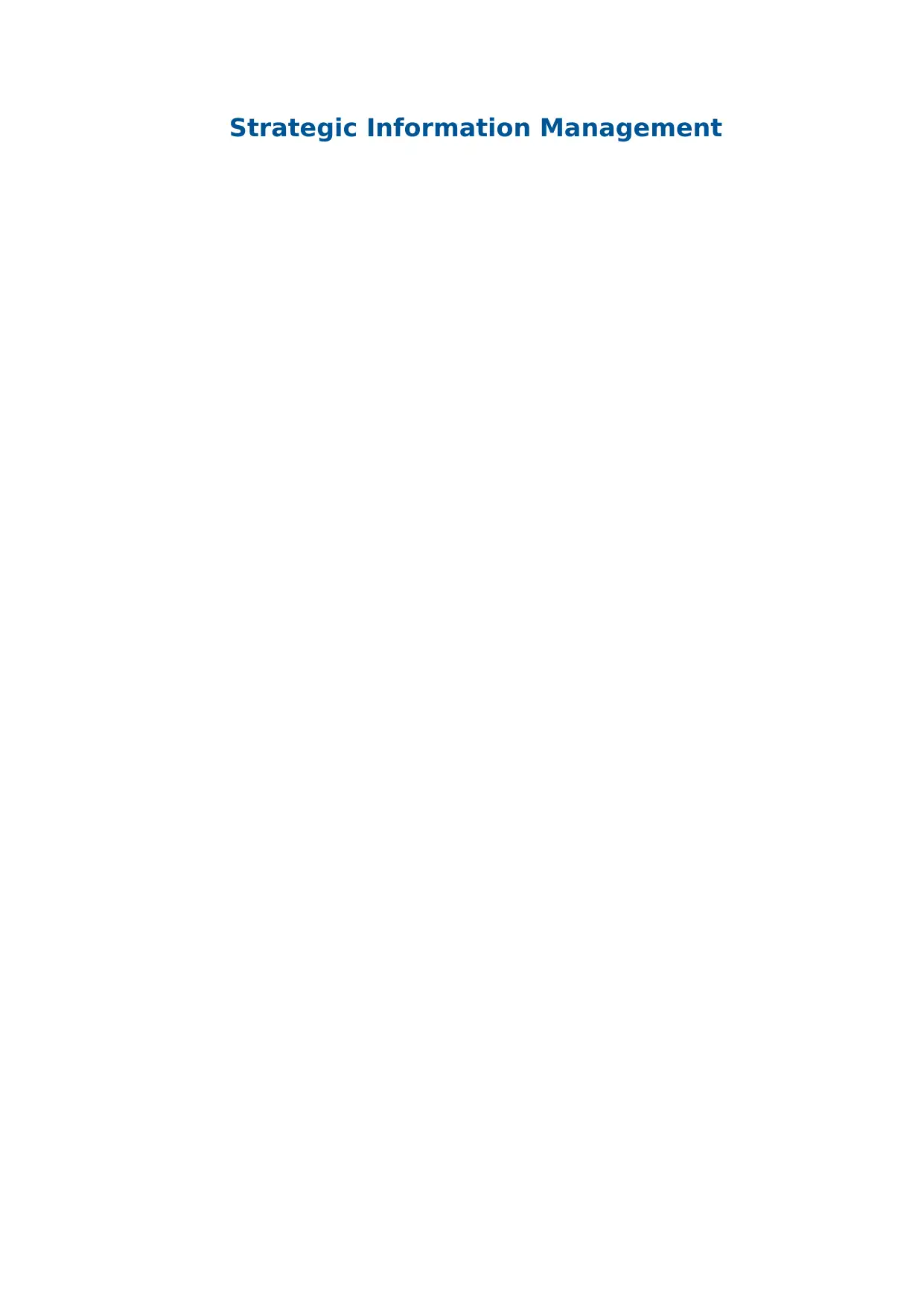
Strategic Information Management
Paraphrase This Document
Need a fresh take? Get an instant paraphrase of this document with our AI Paraphraser
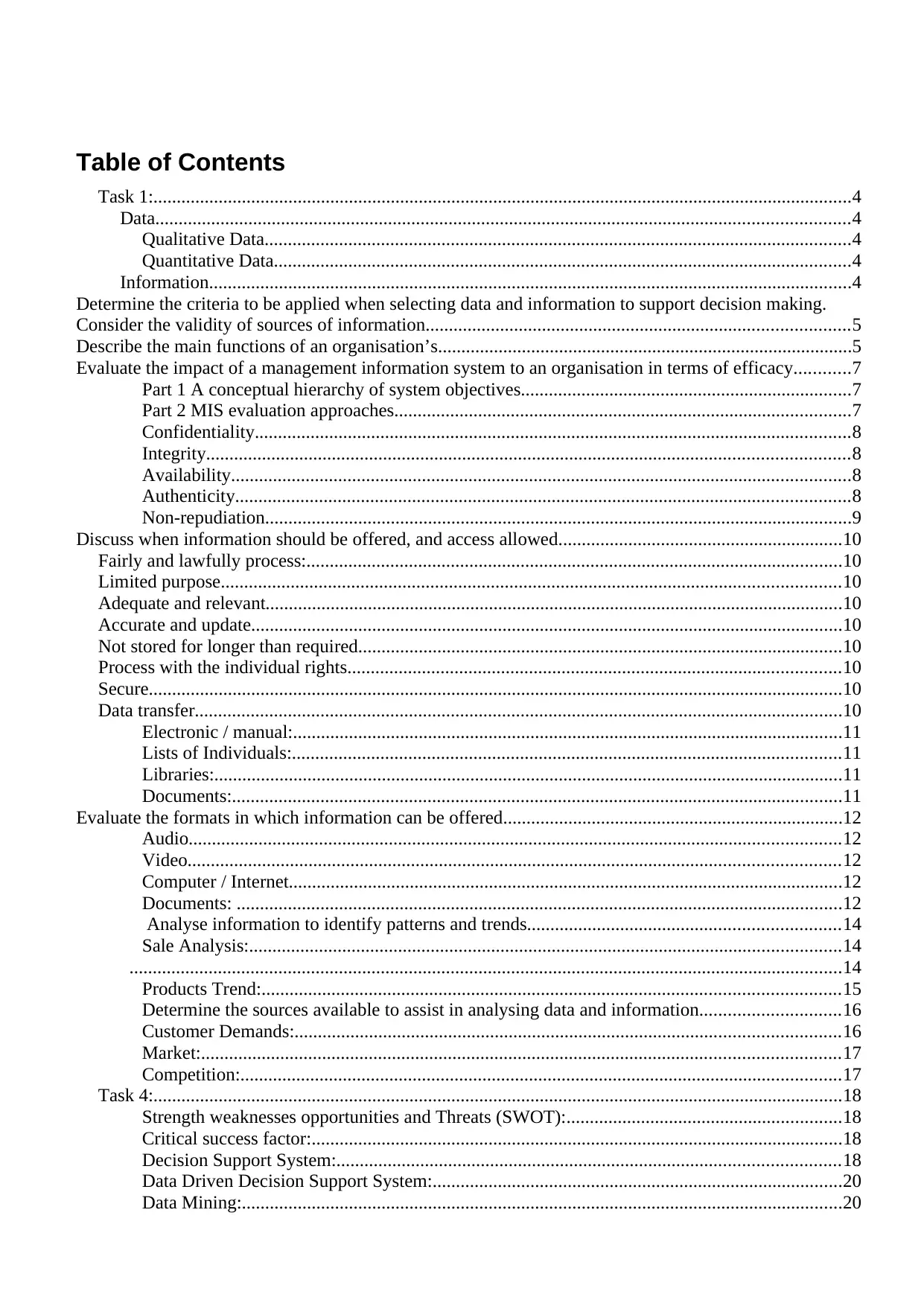
Table of Contents
Task 1:......................................................................................................................................................4
Data.....................................................................................................................................................4
Qualitative Data..............................................................................................................................4
Quantitative Data............................................................................................................................4
Information..........................................................................................................................................4
Determine the criteria to be applied when selecting data and information to support decision making.
Consider the validity of sources of information...........................................................................................5
Describe the main functions of an organisation’s.........................................................................................5
Evaluate the impact of a management information system to an organisation in terms of efficacy............7
Part 1 A conceptual hierarchy of system objectives.......................................................................7
Part 2 MIS evaluation approaches..................................................................................................7
Confidentiality................................................................................................................................8
Integrity..........................................................................................................................................8
Availability.....................................................................................................................................8
Authenticity....................................................................................................................................8
Non-repudiation..............................................................................................................................9
Discuss when information should be offered, and access allowed.............................................................10
Fairly and lawfully process:...................................................................................................................10
Limited purpose.....................................................................................................................................10
Adequate and relevant............................................................................................................................10
Accurate and update...............................................................................................................................10
Not stored for longer than required........................................................................................................10
Process with the individual rights..........................................................................................................10
Secure.....................................................................................................................................................10
Data transfer...........................................................................................................................................10
Electronic / manual:......................................................................................................................11
Lists of Individuals:......................................................................................................................11
Libraries:.......................................................................................................................................11
Documents:...................................................................................................................................11
Evaluate the formats in which information can be offered.........................................................................12
Audio............................................................................................................................................12
Video............................................................................................................................................12
Computer / Internet.......................................................................................................................12
Documents: ..................................................................................................................................12
Analyse information to identify patterns and trends...................................................................14
Sale Analysis:...............................................................................................................................14
.........................................................................................................................................................14
Products Trend:............................................................................................................................15
Determine the sources available to assist in analysing data and information..............................16
Customer Demands:.....................................................................................................................16
Market:.........................................................................................................................................17
Competition:.................................................................................................................................17
Task 4:....................................................................................................................................................18
Strength weaknesses opportunities and Threats (SWOT):...........................................................18
Critical success factor:..................................................................................................................18
Decision Support System:............................................................................................................18
Data Driven Decision Support System:........................................................................................20
Data Mining:.................................................................................................................................20
Task 1:......................................................................................................................................................4
Data.....................................................................................................................................................4
Qualitative Data..............................................................................................................................4
Quantitative Data............................................................................................................................4
Information..........................................................................................................................................4
Determine the criteria to be applied when selecting data and information to support decision making.
Consider the validity of sources of information...........................................................................................5
Describe the main functions of an organisation’s.........................................................................................5
Evaluate the impact of a management information system to an organisation in terms of efficacy............7
Part 1 A conceptual hierarchy of system objectives.......................................................................7
Part 2 MIS evaluation approaches..................................................................................................7
Confidentiality................................................................................................................................8
Integrity..........................................................................................................................................8
Availability.....................................................................................................................................8
Authenticity....................................................................................................................................8
Non-repudiation..............................................................................................................................9
Discuss when information should be offered, and access allowed.............................................................10
Fairly and lawfully process:...................................................................................................................10
Limited purpose.....................................................................................................................................10
Adequate and relevant............................................................................................................................10
Accurate and update...............................................................................................................................10
Not stored for longer than required........................................................................................................10
Process with the individual rights..........................................................................................................10
Secure.....................................................................................................................................................10
Data transfer...........................................................................................................................................10
Electronic / manual:......................................................................................................................11
Lists of Individuals:......................................................................................................................11
Libraries:.......................................................................................................................................11
Documents:...................................................................................................................................11
Evaluate the formats in which information can be offered.........................................................................12
Audio............................................................................................................................................12
Video............................................................................................................................................12
Computer / Internet.......................................................................................................................12
Documents: ..................................................................................................................................12
Analyse information to identify patterns and trends...................................................................14
Sale Analysis:...............................................................................................................................14
.........................................................................................................................................................14
Products Trend:............................................................................................................................15
Determine the sources available to assist in analysing data and information..............................16
Customer Demands:.....................................................................................................................16
Market:.........................................................................................................................................17
Competition:.................................................................................................................................17
Task 4:....................................................................................................................................................18
Strength weaknesses opportunities and Threats (SWOT):...........................................................18
Critical success factor:..................................................................................................................18
Decision Support System:............................................................................................................18
Data Driven Decision Support System:........................................................................................20
Data Mining:.................................................................................................................................20
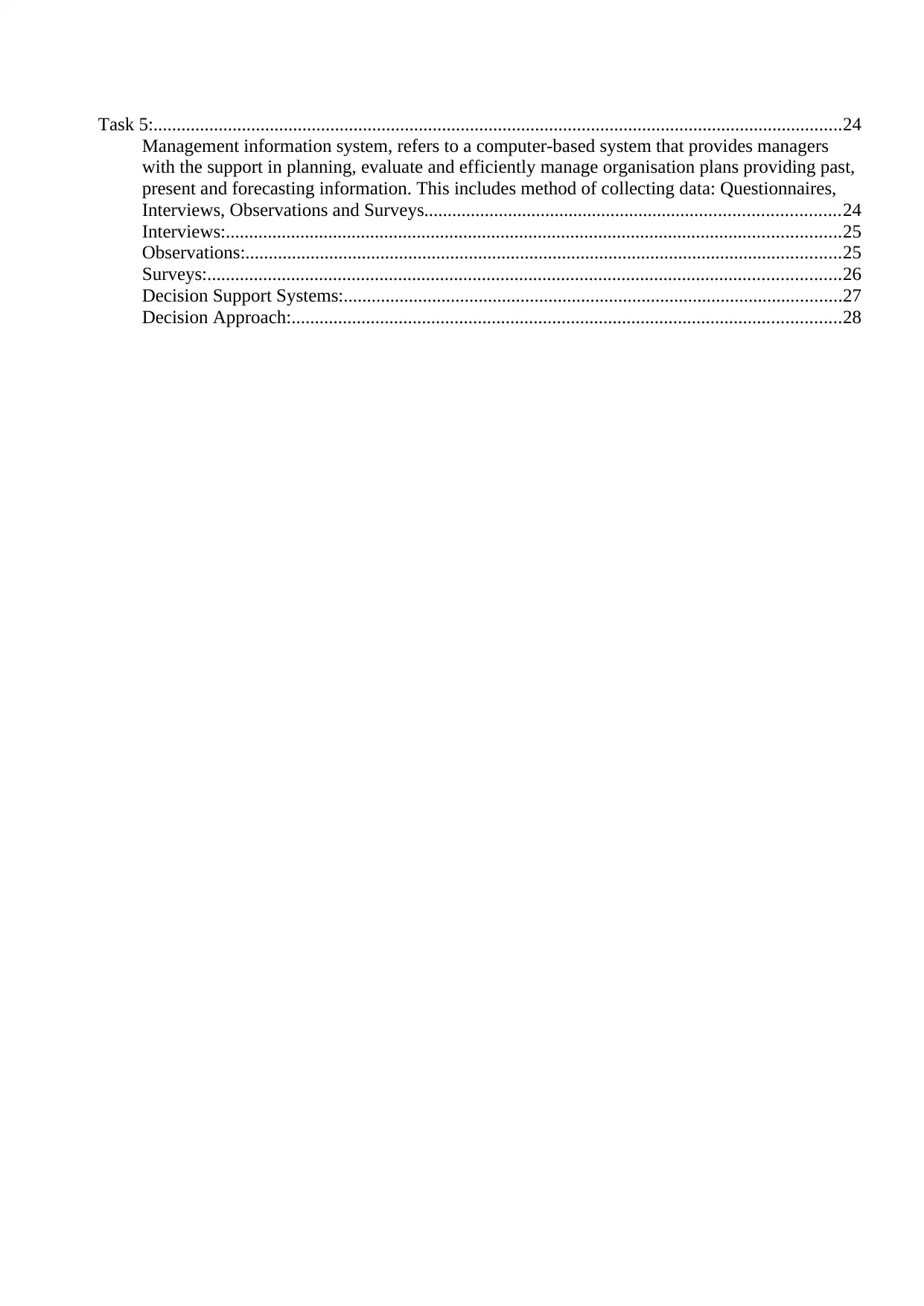
Task 5:....................................................................................................................................................24
Management information system, refers to a computer-based system that provides managers
with the support in planning, evaluate and efficiently manage organisation plans providing past,
present and forecasting information. This includes method of collecting data: Questionnaires,
Interviews, Observations and Surveys.........................................................................................24
Interviews:....................................................................................................................................25
Observations:................................................................................................................................25
Surveys:........................................................................................................................................26
Decision Support Systems:...........................................................................................................27
Decision Approach:......................................................................................................................28
Management information system, refers to a computer-based system that provides managers
with the support in planning, evaluate and efficiently manage organisation plans providing past,
present and forecasting information. This includes method of collecting data: Questionnaires,
Interviews, Observations and Surveys.........................................................................................24
Interviews:....................................................................................................................................25
Observations:................................................................................................................................25
Surveys:........................................................................................................................................26
Decision Support Systems:...........................................................................................................27
Decision Approach:......................................................................................................................28
⊘ This is a preview!⊘
Do you want full access?
Subscribe today to unlock all pages.

Trusted by 1+ million students worldwide
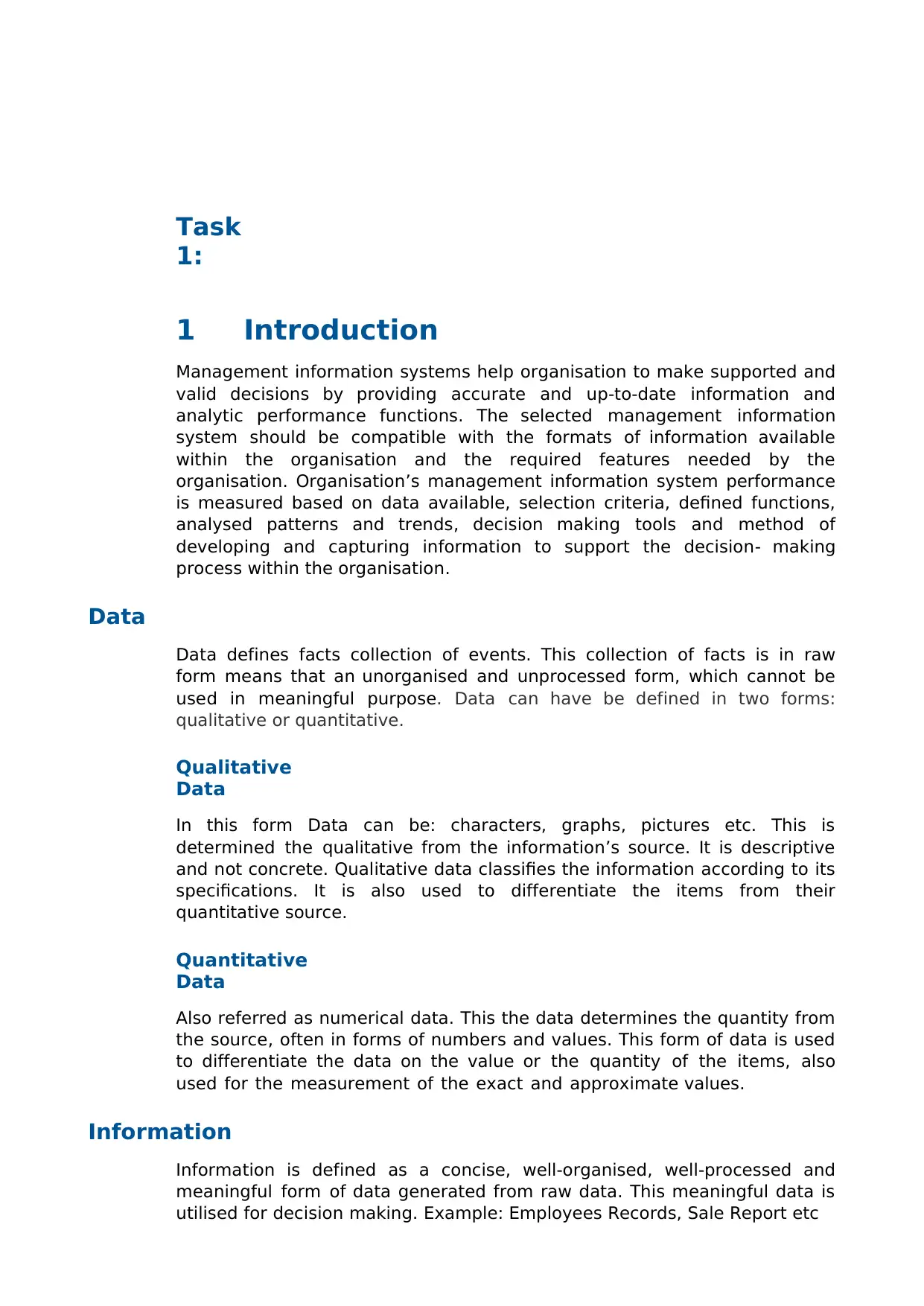
Task
1:
1 Introduction
Management information systems help organisation to make supported and
valid decisions by providing accurate and up-to-date information and
analytic performance functions. The selected management information
system should be compatible with the formats of information available
within the organisation and the required features needed by the
organisation. Organisation’s management information system performance
is measured based on data available, selection criteria, defined functions,
analysed patterns and trends, decision making tools and method of
developing and capturing information to support the decision- making
process within the organisation.
Data
Data defines facts collection of events. This collection of facts is in raw
form means that an unorganised and unprocessed form, which cannot be
used in meaningful purpose. Data can have be defined in two forms:
qualitative or quantitative.
Qualitative
Data
In this form Data can be: characters, graphs, pictures etc. This is
determined the qualitative from the information’s source. It is descriptive
and not concrete. Qualitative data classifies the information according to its
specifications. It is also used to differentiate the items from their
quantitative source.
Quantitative
Data
Also referred as numerical data. This the data determines the quantity from
the source, often in forms of numbers and values. This form of data is used
to differentiate the data on the value or the quantity of the items, also
used for the measurement of the exact and approximate values.
Information
Information is defined as a concise, well-organised, well-processed and
meaningful form of data generated from raw data. This meaningful data is
utilised for decision making. Example: Employees Records, Sale Report etc
1:
1 Introduction
Management information systems help organisation to make supported and
valid decisions by providing accurate and up-to-date information and
analytic performance functions. The selected management information
system should be compatible with the formats of information available
within the organisation and the required features needed by the
organisation. Organisation’s management information system performance
is measured based on data available, selection criteria, defined functions,
analysed patterns and trends, decision making tools and method of
developing and capturing information to support the decision- making
process within the organisation.
Data
Data defines facts collection of events. This collection of facts is in raw
form means that an unorganised and unprocessed form, which cannot be
used in meaningful purpose. Data can have be defined in two forms:
qualitative or quantitative.
Qualitative
Data
In this form Data can be: characters, graphs, pictures etc. This is
determined the qualitative from the information’s source. It is descriptive
and not concrete. Qualitative data classifies the information according to its
specifications. It is also used to differentiate the items from their
quantitative source.
Quantitative
Data
Also referred as numerical data. This the data determines the quantity from
the source, often in forms of numbers and values. This form of data is used
to differentiate the data on the value or the quantity of the items, also
used for the measurement of the exact and approximate values.
Information
Information is defined as a concise, well-organised, well-processed and
meaningful form of data generated from raw data. This meaningful data is
utilised for decision making. Example: Employees Records, Sale Report etc
Paraphrase This Document
Need a fresh take? Get an instant paraphrase of this document with our AI Paraphraser
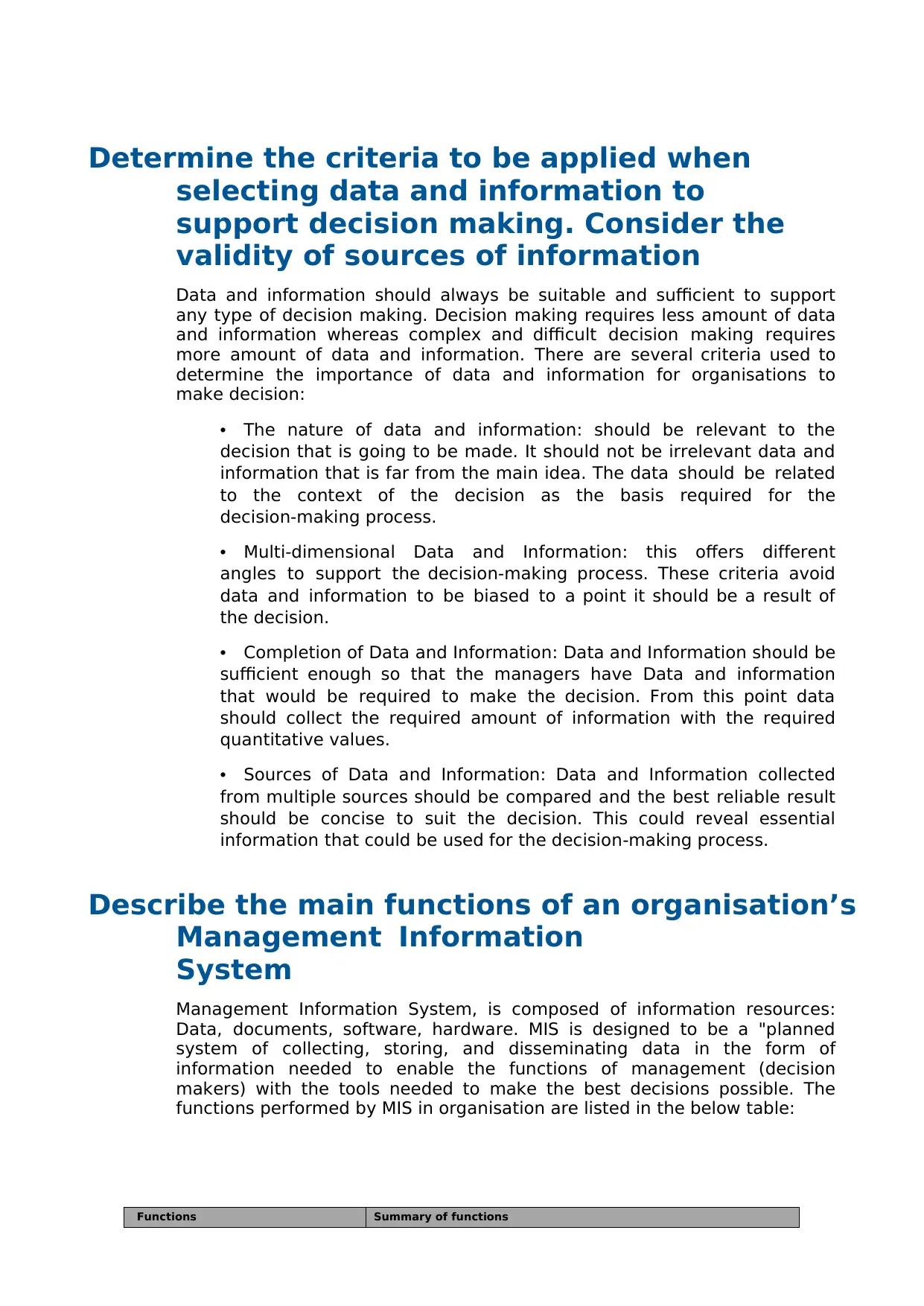
Determine the criteria to be applied when
selecting data and information to
support decision making. Consider the
validity of sources of information
Data and information should always be suitable and sufficient to support
any type of decision making. Decision making requires less amount of data
and information whereas complex and difficult decision making requires
more amount of data and information. There are several criteria used to
determine the importance of data and information for organisations to
make decision:
• The nature of data and information: should be relevant to the
decision that is going to be made. It should not be irrelevant data and
information that is far from the main idea. The data should be related
to the context of the decision as the basis required for the
decision-making process.
• Multi-dimensional Data and Information: this offers different
angles to support the decision-making process. These criteria avoid
data and information to be biased to a point it should be a result of
the decision.
• Completion of Data and Information: Data and Information should be
sufficient enough so that the managers have Data and information
that would be required to make the decision. From this point data
should collect the required amount of information with the required
quantitative values.
• Sources of Data and Information: Data and Information collected
from multiple sources should be compared and the best reliable result
should be concise to suit the decision. This could reveal essential
information that could be used for the decision-making process.
Describe the main functions of an organisation’s
Management Information
System
Management Information System, is composed of information resources:
Data, documents, software, hardware. MIS is designed to be a "planned
system of collecting, storing, and disseminating data in the form of
information needed to enable the functions of management (decision
makers) with the tools needed to make the best decisions possible. The
functions performed by MIS in organisation are listed in the below table:
Functions Summary of functions
selecting data and information to
support decision making. Consider the
validity of sources of information
Data and information should always be suitable and sufficient to support
any type of decision making. Decision making requires less amount of data
and information whereas complex and difficult decision making requires
more amount of data and information. There are several criteria used to
determine the importance of data and information for organisations to
make decision:
• The nature of data and information: should be relevant to the
decision that is going to be made. It should not be irrelevant data and
information that is far from the main idea. The data should be related
to the context of the decision as the basis required for the
decision-making process.
• Multi-dimensional Data and Information: this offers different
angles to support the decision-making process. These criteria avoid
data and information to be biased to a point it should be a result of
the decision.
• Completion of Data and Information: Data and Information should be
sufficient enough so that the managers have Data and information
that would be required to make the decision. From this point data
should collect the required amount of information with the required
quantitative values.
• Sources of Data and Information: Data and Information collected
from multiple sources should be compared and the best reliable result
should be concise to suit the decision. This could reveal essential
information that could be used for the decision-making process.
Describe the main functions of an organisation’s
Management Information
System
Management Information System, is composed of information resources:
Data, documents, software, hardware. MIS is designed to be a "planned
system of collecting, storing, and disseminating data in the form of
information needed to enable the functions of management (decision
makers) with the tools needed to make the best decisions possible. The
functions performed by MIS in organisation are listed in the below table:
Functions Summary of functions
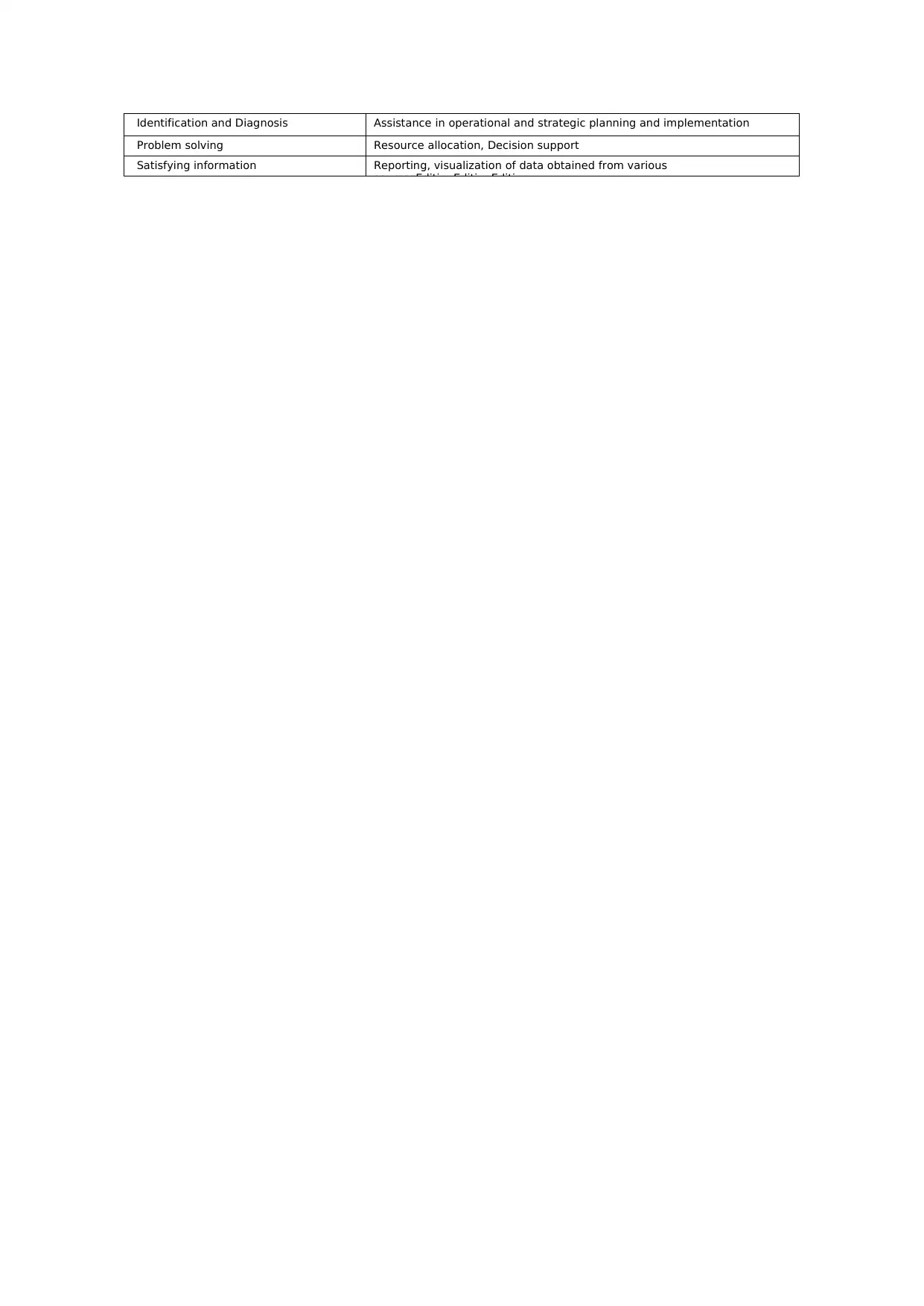
Identification and Diagnosis Assistance in operational and strategic planning and implementation
Problem solving Resource allocation, Decision support
Satisfying information Reporting, visualization of data obtained from various
sourcesEditingEditingEditing
Problem solving Resource allocation, Decision support
Satisfying information Reporting, visualization of data obtained from various
sourcesEditingEditingEditing
⊘ This is a preview!⊘
Do you want full access?
Subscribe today to unlock all pages.

Trusted by 1+ million students worldwide
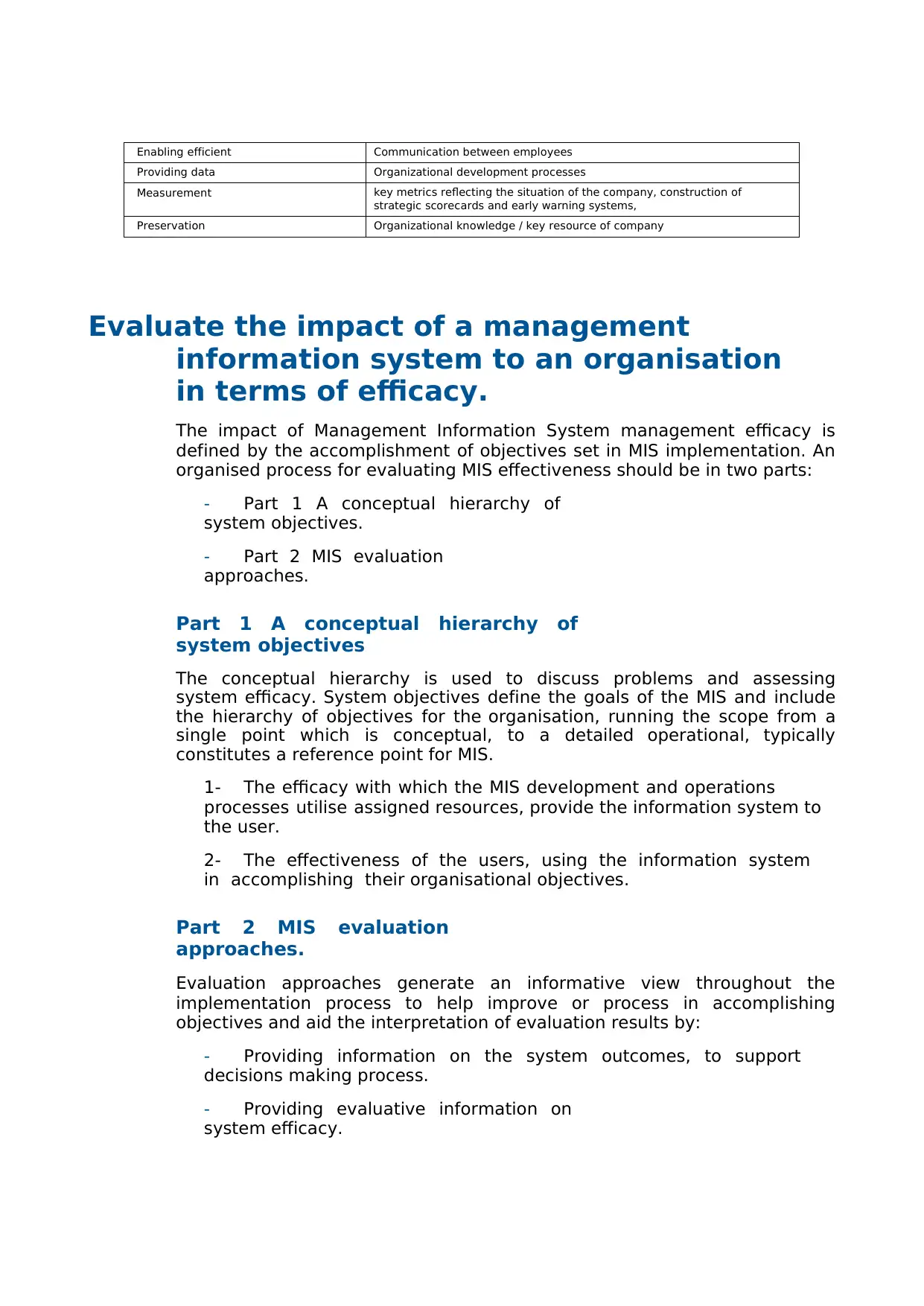
Enabling efficient Communication between employees
Providing data Organizational development processes
Measurement key metrics reflecting the situation of the company, construction of
strategic scorecards and early warning systems,
Preservation Organizational knowledge / key resource of company
Evaluate the impact of a management
information system to an organisation
in terms of efficacy.
The impact of Management Information System management efficacy is
defined by the accomplishment of objectives set in MIS implementation. An
organised process for evaluating MIS effectiveness should be in two parts:
- Part 1 A conceptual hierarchy of
system objectives.
- Part 2 MIS evaluation
approaches.
Part 1 A conceptual hierarchy of
system objectives
The conceptual hierarchy is used to discuss problems and assessing
system efficacy. System objectives define the goals of the MIS and include
the hierarchy of objectives for the organisation, running the scope from a
single point which is conceptual, to a detailed operational, typically
constitutes a reference point for MIS.
1- The efficacy with which the MIS development and operations
processes utilise assigned resources, provide the information system to
the user.
2- The effectiveness of the users, using the information system
in accomplishing their organisational objectives.
Part 2 MIS evaluation
approaches.
Evaluation approaches generate an informative view throughout the
implementation process to help improve or process in accomplishing
objectives and aid the interpretation of evaluation results by:
- Providing information on the system outcomes, to support
decisions making process.
- Providing evaluative information on
system efficacy.
Providing data Organizational development processes
Measurement key metrics reflecting the situation of the company, construction of
strategic scorecards and early warning systems,
Preservation Organizational knowledge / key resource of company
Evaluate the impact of a management
information system to an organisation
in terms of efficacy.
The impact of Management Information System management efficacy is
defined by the accomplishment of objectives set in MIS implementation. An
organised process for evaluating MIS effectiveness should be in two parts:
- Part 1 A conceptual hierarchy of
system objectives.
- Part 2 MIS evaluation
approaches.
Part 1 A conceptual hierarchy of
system objectives
The conceptual hierarchy is used to discuss problems and assessing
system efficacy. System objectives define the goals of the MIS and include
the hierarchy of objectives for the organisation, running the scope from a
single point which is conceptual, to a detailed operational, typically
constitutes a reference point for MIS.
1- The efficacy with which the MIS development and operations
processes utilise assigned resources, provide the information system to
the user.
2- The effectiveness of the users, using the information system
in accomplishing their organisational objectives.
Part 2 MIS evaluation
approaches.
Evaluation approaches generate an informative view throughout the
implementation process to help improve or process in accomplishing
objectives and aid the interpretation of evaluation results by:
- Providing information on the system outcomes, to support
decisions making process.
- Providing evaluative information on
system efficacy.
Paraphrase This Document
Need a fresh take? Get an instant paraphrase of this document with our AI Paraphraser
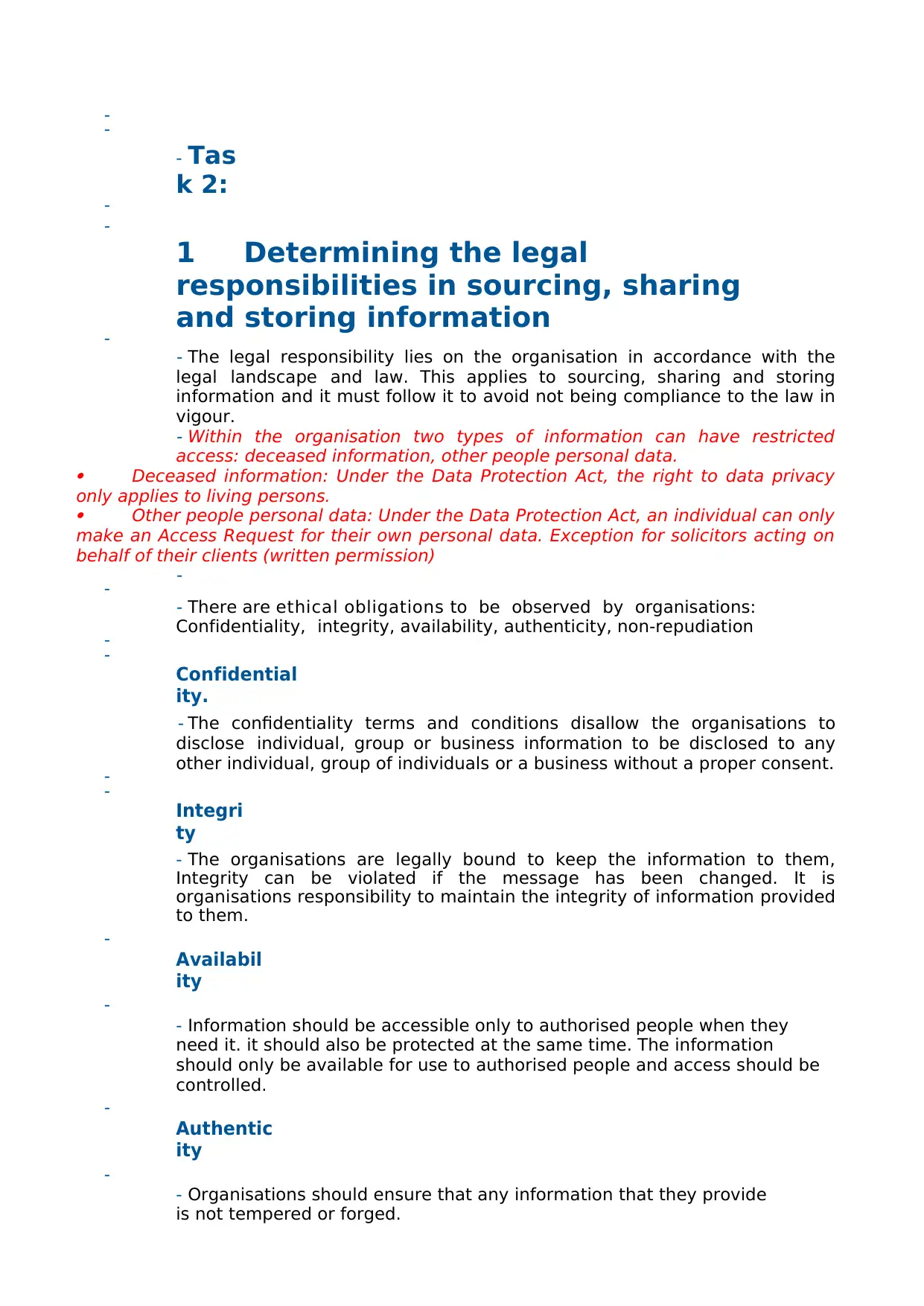
-
-
- Tas
k 2:
-
-
1 Determining the legal
responsibilities in sourcing, sharing
and storing information
-
- The legal responsibility lies on the organisation in accordance with the
legal landscape and law. This applies to sourcing, sharing and storing
information and it must follow it to avoid not being compliance to the law in
vigour.
- Within the organisation two types of information can have restricted
access: deceased information, other people personal data. Deceased information: Under the Data Protection Act, the right to data privacy
only applies to living persons. Other people personal data: Under the Data Protection Act, an individual can only
make an Access Request for their own personal data. Exception for solicitors acting on
behalf of their clients (written permission)
-
-
- There are ethical obligations to be observed by organisations:
Confidentiality, integrity, availability, authenticity, non-repudiation
-
-
Confidential
ity.
- The confidentiality terms and conditions disallow the organisations to
disclose individual, group or business information to be disclosed to any
other individual, group of individuals or a business without a proper consent.
-
-
Integri
ty
- The organisations are legally bound to keep the information to them,
Integrity can be violated if the message has been changed. It is
organisations responsibility to maintain the integrity of information provided
to them.
-
Availabil
ity
-
- Information should be accessible only to authorised people when they
need it. it should also be protected at the same time. The information
should only be available for use to authorised people and access should be
controlled.
-
Authentic
ity
-
- Organisations should ensure that any information that they provide
is not tempered or forged.
-
- Tas
k 2:
-
-
1 Determining the legal
responsibilities in sourcing, sharing
and storing information
-
- The legal responsibility lies on the organisation in accordance with the
legal landscape and law. This applies to sourcing, sharing and storing
information and it must follow it to avoid not being compliance to the law in
vigour.
- Within the organisation two types of information can have restricted
access: deceased information, other people personal data. Deceased information: Under the Data Protection Act, the right to data privacy
only applies to living persons. Other people personal data: Under the Data Protection Act, an individual can only
make an Access Request for their own personal data. Exception for solicitors acting on
behalf of their clients (written permission)
-
-
- There are ethical obligations to be observed by organisations:
Confidentiality, integrity, availability, authenticity, non-repudiation
-
-
Confidential
ity.
- The confidentiality terms and conditions disallow the organisations to
disclose individual, group or business information to be disclosed to any
other individual, group of individuals or a business without a proper consent.
-
-
Integri
ty
- The organisations are legally bound to keep the information to them,
Integrity can be violated if the message has been changed. It is
organisations responsibility to maintain the integrity of information provided
to them.
-
Availabil
ity
-
- Information should be accessible only to authorised people when they
need it. it should also be protected at the same time. The information
should only be available for use to authorised people and access should be
controlled.
-
Authentic
ity
-
- Organisations should ensure that any information that they provide
is not tempered or forged.
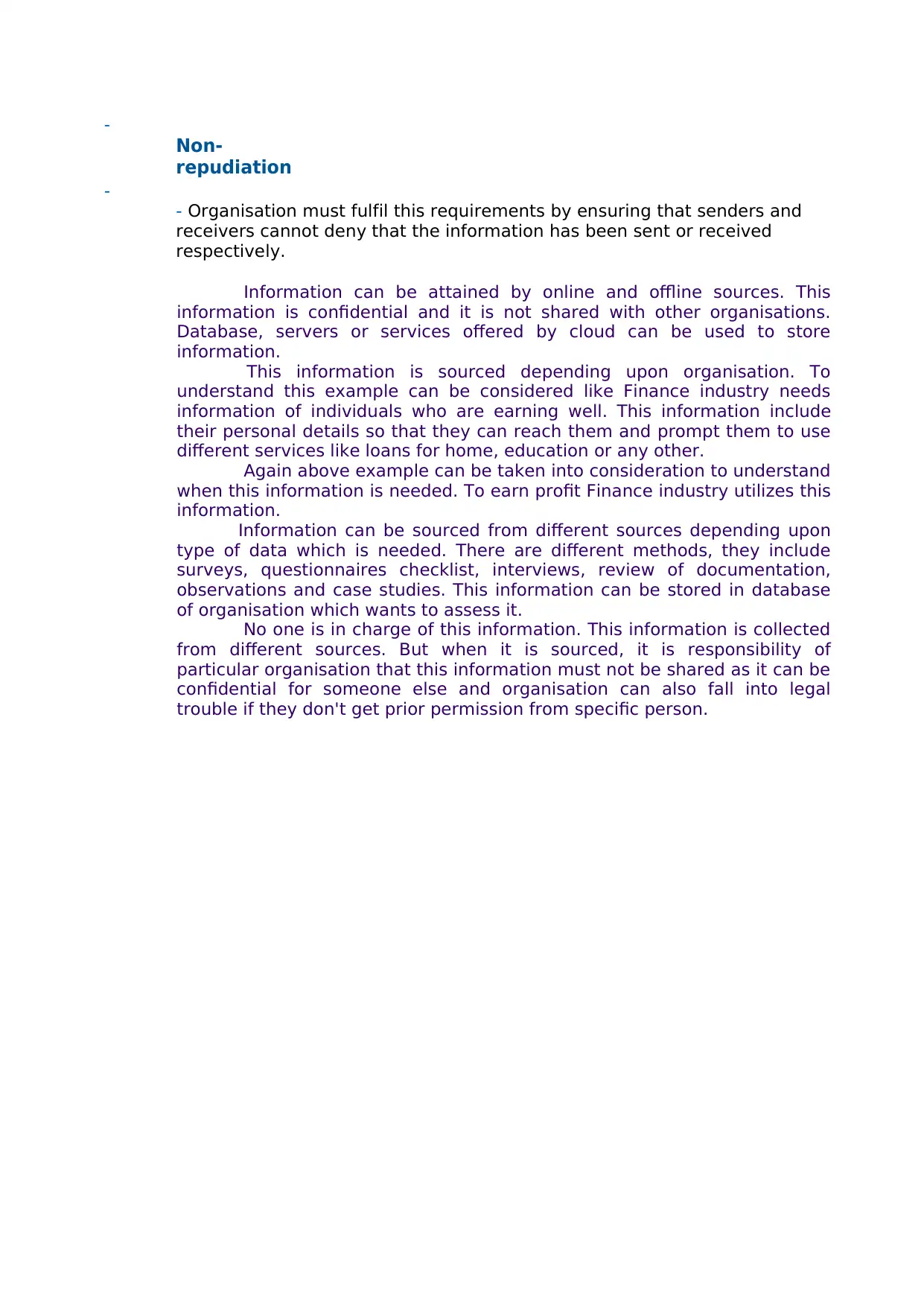
-
Non-
repudiation
-
- Organisation must fulfil this requirements by ensuring that senders and
receivers cannot deny that the information has been sent or received
respectively.
Information can be attained by online and offline sources. This
information is confidential and it is not shared with other organisations.
Database, servers or services offered by cloud can be used to store
information.
This information is sourced depending upon organisation. To
understand this example can be considered like Finance industry needs
information of individuals who are earning well. This information include
their personal details so that they can reach them and prompt them to use
different services like loans for home, education or any other.
Again above example can be taken into consideration to understand
when this information is needed. To earn profit Finance industry utilizes this
information.
Information can be sourced from different sources depending upon
type of data which is needed. There are different methods, they include
surveys, questionnaires checklist, interviews, review of documentation,
observations and case studies. This information can be stored in database
of organisation which wants to assess it.
No one is in charge of this information. This information is collected
from different sources. But when it is sourced, it is responsibility of
particular organisation that this information must not be shared as it can be
confidential for someone else and organisation can also fall into legal
trouble if they don't get prior permission from specific person.
Non-
repudiation
-
- Organisation must fulfil this requirements by ensuring that senders and
receivers cannot deny that the information has been sent or received
respectively.
Information can be attained by online and offline sources. This
information is confidential and it is not shared with other organisations.
Database, servers or services offered by cloud can be used to store
information.
This information is sourced depending upon organisation. To
understand this example can be considered like Finance industry needs
information of individuals who are earning well. This information include
their personal details so that they can reach them and prompt them to use
different services like loans for home, education or any other.
Again above example can be taken into consideration to understand
when this information is needed. To earn profit Finance industry utilizes this
information.
Information can be sourced from different sources depending upon
type of data which is needed. There are different methods, they include
surveys, questionnaires checklist, interviews, review of documentation,
observations and case studies. This information can be stored in database
of organisation which wants to assess it.
No one is in charge of this information. This information is collected
from different sources. But when it is sourced, it is responsibility of
particular organisation that this information must not be shared as it can be
confidential for someone else and organisation can also fall into legal
trouble if they don't get prior permission from specific person.
⊘ This is a preview!⊘
Do you want full access?
Subscribe today to unlock all pages.

Trusted by 1+ million students worldwide
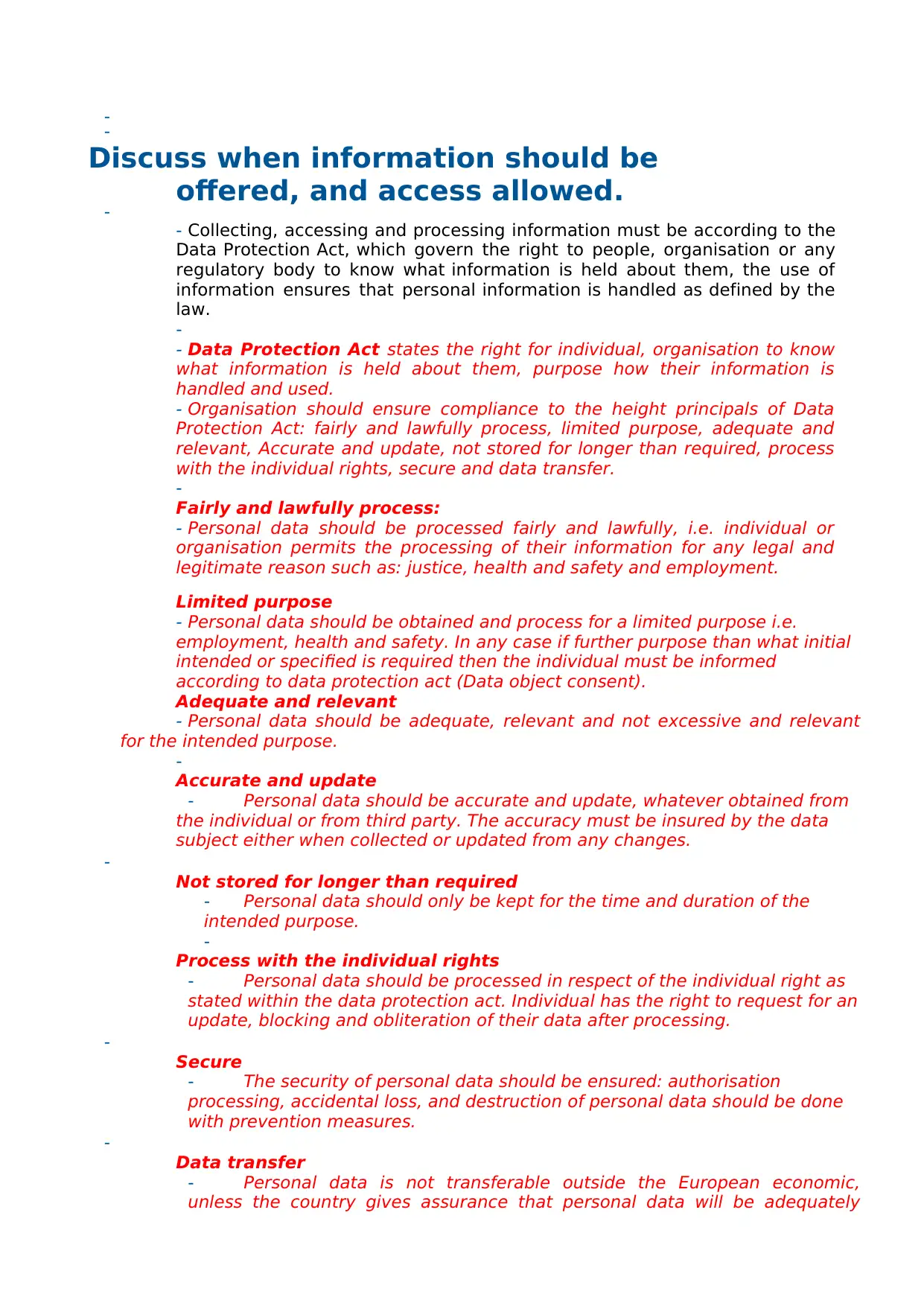
-
-
Discuss when information should be
offered, and access allowed.
-
- Collecting, accessing and processing information must be according to the
Data Protection Act, which govern the right to people, organisation or any
regulatory body to know what information is held about them, the use of
information ensures that personal information is handled as defined by the
law.
-
- Data Protection Act states the right for individual, organisation to know
what information is held about them, purpose how their information is
handled and used.
- Organisation should ensure compliance to the height principals of Data
Protection Act: fairly and lawfully process, limited purpose, adequate and
relevant, Accurate and update, not stored for longer than required, process
with the individual rights, secure and data transfer.
-
Fairly and lawfully process:
- Personal data should be processed fairly and lawfully, i.e. individual or
organisation permits the processing of their information for any legal and
legitimate reason such as: justice, health and safety and employment.
Limited purpose
- Personal data should be obtained and process for a limited purpose i.e.
employment, health and safety. In any case if further purpose than what initial
intended or specified is required then the individual must be informed
according to data protection act (Data object consent).
Adequate and relevant
- Personal data should be adequate, relevant and not excessive and relevant
for the intended purpose.
-
Accurate and update
- Personal data should be accurate and update, whatever obtained from
the individual or from third party. The accuracy must be insured by the data
subject either when collected or updated from any changes.
-
Not stored for longer than required
- Personal data should only be kept for the time and duration of the
intended purpose.
-
Process with the individual rights
- Personal data should be processed in respect of the individual right as
stated within the data protection act. Individual has the right to request for an
update, blocking and obliteration of their data after processing.
-
Secure
- The security of personal data should be ensured: authorisation
processing, accidental loss, and destruction of personal data should be done
with prevention measures.
-
Data transfer
- Personal data is not transferable outside the European economic,
unless the country gives assurance that personal data will be adequately
-
Discuss when information should be
offered, and access allowed.
-
- Collecting, accessing and processing information must be according to the
Data Protection Act, which govern the right to people, organisation or any
regulatory body to know what information is held about them, the use of
information ensures that personal information is handled as defined by the
law.
-
- Data Protection Act states the right for individual, organisation to know
what information is held about them, purpose how their information is
handled and used.
- Organisation should ensure compliance to the height principals of Data
Protection Act: fairly and lawfully process, limited purpose, adequate and
relevant, Accurate and update, not stored for longer than required, process
with the individual rights, secure and data transfer.
-
Fairly and lawfully process:
- Personal data should be processed fairly and lawfully, i.e. individual or
organisation permits the processing of their information for any legal and
legitimate reason such as: justice, health and safety and employment.
Limited purpose
- Personal data should be obtained and process for a limited purpose i.e.
employment, health and safety. In any case if further purpose than what initial
intended or specified is required then the individual must be informed
according to data protection act (Data object consent).
Adequate and relevant
- Personal data should be adequate, relevant and not excessive and relevant
for the intended purpose.
-
Accurate and update
- Personal data should be accurate and update, whatever obtained from
the individual or from third party. The accuracy must be insured by the data
subject either when collected or updated from any changes.
-
Not stored for longer than required
- Personal data should only be kept for the time and duration of the
intended purpose.
-
Process with the individual rights
- Personal data should be processed in respect of the individual right as
stated within the data protection act. Individual has the right to request for an
update, blocking and obliteration of their data after processing.
-
Secure
- The security of personal data should be ensured: authorisation
processing, accidental loss, and destruction of personal data should be done
with prevention measures.
-
Data transfer
- Personal data is not transferable outside the European economic,
unless the country gives assurance that personal data will be adequately
Paraphrase This Document
Need a fresh take? Get an instant paraphrase of this document with our AI Paraphraser
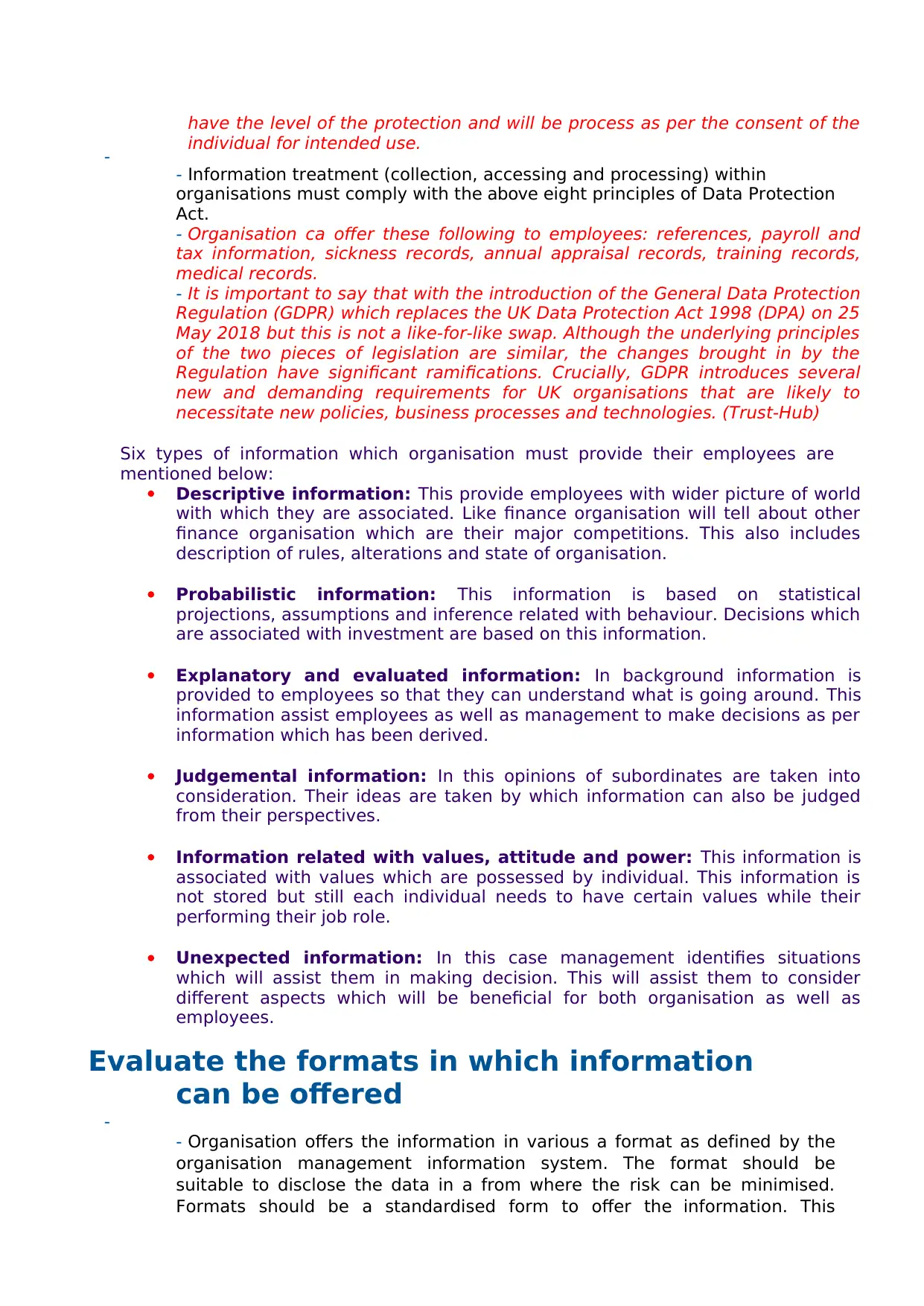
have the level of the protection and will be process as per the consent of the
individual for intended use.
-
- Information treatment (collection, accessing and processing) within
organisations must comply with the above eight principles of Data Protection
Act.
- Organisation ca offer these following to employees: references, payroll and
tax information, sickness records, annual appraisal records, training records,
medical records.
- It is important to say that with the introduction of the General Data Protection
Regulation (GDPR) which replaces the UK Data Protection Act 1998 (DPA) on 25
May 2018 but this is not a like-for-like swap. Although the underlying principles
of the two pieces of legislation are similar, the changes brought in by the
Regulation have significant ramifications. Crucially, GDPR introduces several
new and demanding requirements for UK organisations that are likely to
necessitate new policies, business processes and technologies. (Trust-Hub)
Six types of information which organisation must provide their employees are
mentioned below:
Descriptive information: This provide employees with wider picture of world
with which they are associated. Like finance organisation will tell about other
finance organisation which are their major competitions. This also includes
description of rules, alterations and state of organisation.
Probabilistic information: This information is based on statistical
projections, assumptions and inference related with behaviour. Decisions which
are associated with investment are based on this information.
Explanatory and evaluated information: In background information is
provided to employees so that they can understand what is going around. This
information assist employees as well as management to make decisions as per
information which has been derived.
Judgemental information: In this opinions of subordinates are taken into
consideration. Their ideas are taken by which information can also be judged
from their perspectives.
Information related with values, attitude and power: This information is
associated with values which are possessed by individual. This information is
not stored but still each individual needs to have certain values while their
performing their job role.
Unexpected information: In this case management identifies situations
which will assist them in making decision. This will assist them to consider
different aspects which will be beneficial for both organisation as well as
employees.
Evaluate the formats in which information
can be offered
-
- Organisation offers the information in various a format as defined by the
organisation management information system. The format should be
suitable to disclose the data in a from where the risk can be minimised.
Formats should be a standardised form to offer the information. This
individual for intended use.
-
- Information treatment (collection, accessing and processing) within
organisations must comply with the above eight principles of Data Protection
Act.
- Organisation ca offer these following to employees: references, payroll and
tax information, sickness records, annual appraisal records, training records,
medical records.
- It is important to say that with the introduction of the General Data Protection
Regulation (GDPR) which replaces the UK Data Protection Act 1998 (DPA) on 25
May 2018 but this is not a like-for-like swap. Although the underlying principles
of the two pieces of legislation are similar, the changes brought in by the
Regulation have significant ramifications. Crucially, GDPR introduces several
new and demanding requirements for UK organisations that are likely to
necessitate new policies, business processes and technologies. (Trust-Hub)
Six types of information which organisation must provide their employees are
mentioned below:
Descriptive information: This provide employees with wider picture of world
with which they are associated. Like finance organisation will tell about other
finance organisation which are their major competitions. This also includes
description of rules, alterations and state of organisation.
Probabilistic information: This information is based on statistical
projections, assumptions and inference related with behaviour. Decisions which
are associated with investment are based on this information.
Explanatory and evaluated information: In background information is
provided to employees so that they can understand what is going around. This
information assist employees as well as management to make decisions as per
information which has been derived.
Judgemental information: In this opinions of subordinates are taken into
consideration. Their ideas are taken by which information can also be judged
from their perspectives.
Information related with values, attitude and power: This information is
associated with values which are possessed by individual. This information is
not stored but still each individual needs to have certain values while their
performing their job role.
Unexpected information: In this case management identifies situations
which will assist them in making decision. This will assist them to consider
different aspects which will be beneficial for both organisation as well as
employees.
Evaluate the formats in which information
can be offered
-
- Organisation offers the information in various a format as defined by the
organisation management information system. The format should be
suitable to disclose the data in a from where the risk can be minimised.
Formats should be a standardised form to offer the information. This
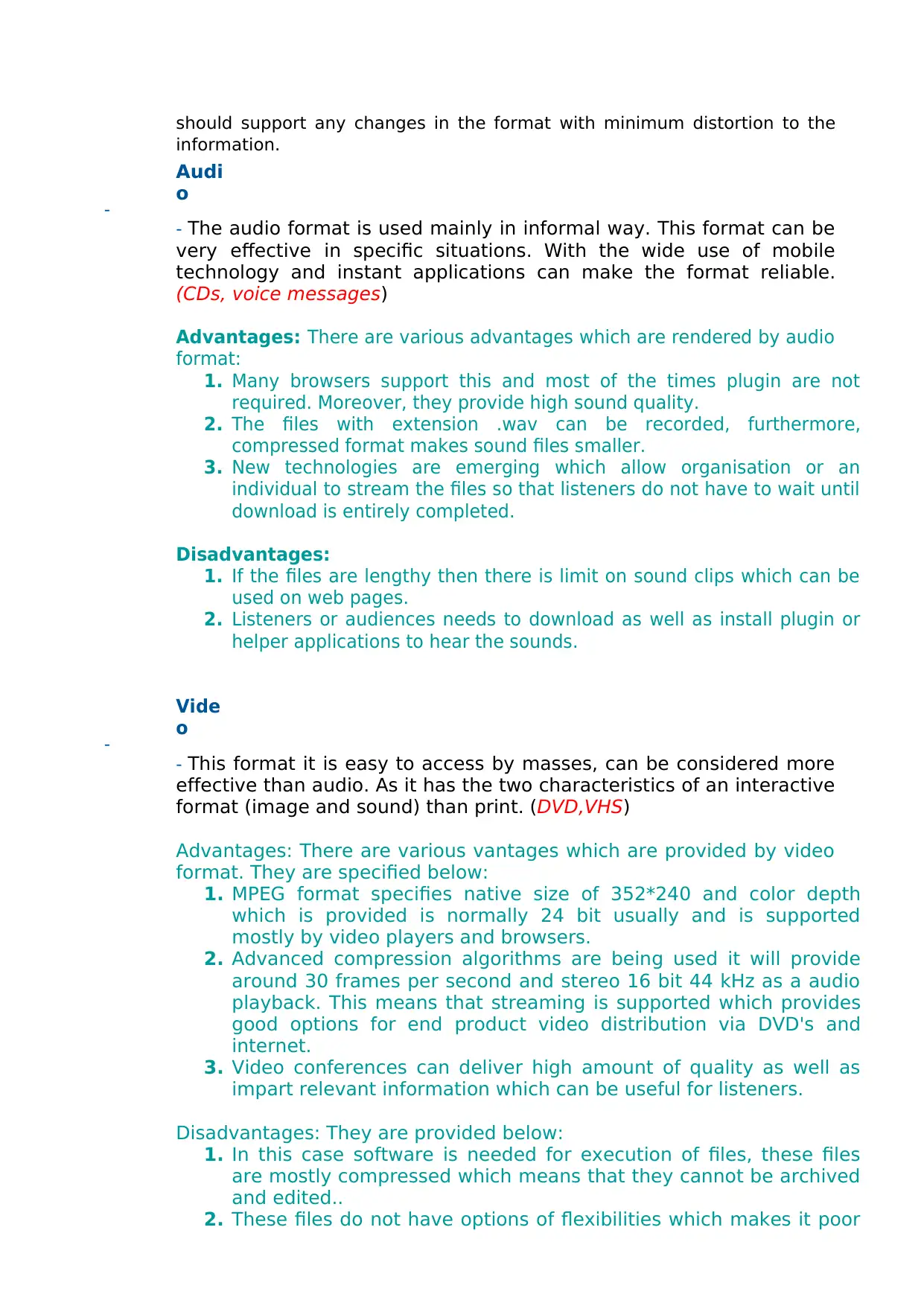
should support any changes in the format with minimum distortion to the
information.
Audi
o
-
- The audio format is used mainly in informal way. This format can be
very effective in specific situations. With the wide use of mobile
technology and instant applications can make the format reliable.
(CDs, voice messages)
Advantages: There are various advantages which are rendered by audio
format:
1. Many browsers support this and most of the times plugin are not
required. Moreover, they provide high sound quality.
2. The files with extension .wav can be recorded, furthermore,
compressed format makes sound files smaller.
3. New technologies are emerging which allow organisation or an
individual to stream the files so that listeners do not have to wait until
download is entirely completed.
Disadvantages:
1. If the files are lengthy then there is limit on sound clips which can be
used on web pages.
2. Listeners or audiences needs to download as well as install plugin or
helper applications to hear the sounds.
Vide
o
-
- This format it is easy to access by masses, can be considered more
effective than audio. As it has the two characteristics of an interactive
format (image and sound) than print. (DVD,VHS)
Advantages: There are various vantages which are provided by video
format. They are specified below:
1. MPEG format specifies native size of 352*240 and color depth
which is provided is normally 24 bit usually and is supported
mostly by video players and browsers.
2. Advanced compression algorithms are being used it will provide
around 30 frames per second and stereo 16 bit 44 kHz as a audio
playback. This means that streaming is supported which provides
good options for end product video distribution via DVD's and
internet.
3. Video conferences can deliver high amount of quality as well as
impart relevant information which can be useful for listeners.
Disadvantages: They are provided below:
1. In this case software is needed for execution of files, these files
are mostly compressed which means that they cannot be archived
and edited..
2. These files do not have options of flexibilities which makes it poor
information.
Audi
o
-
- The audio format is used mainly in informal way. This format can be
very effective in specific situations. With the wide use of mobile
technology and instant applications can make the format reliable.
(CDs, voice messages)
Advantages: There are various advantages which are rendered by audio
format:
1. Many browsers support this and most of the times plugin are not
required. Moreover, they provide high sound quality.
2. The files with extension .wav can be recorded, furthermore,
compressed format makes sound files smaller.
3. New technologies are emerging which allow organisation or an
individual to stream the files so that listeners do not have to wait until
download is entirely completed.
Disadvantages:
1. If the files are lengthy then there is limit on sound clips which can be
used on web pages.
2. Listeners or audiences needs to download as well as install plugin or
helper applications to hear the sounds.
Vide
o
-
- This format it is easy to access by masses, can be considered more
effective than audio. As it has the two characteristics of an interactive
format (image and sound) than print. (DVD,VHS)
Advantages: There are various vantages which are provided by video
format. They are specified below:
1. MPEG format specifies native size of 352*240 and color depth
which is provided is normally 24 bit usually and is supported
mostly by video players and browsers.
2. Advanced compression algorithms are being used it will provide
around 30 frames per second and stereo 16 bit 44 kHz as a audio
playback. This means that streaming is supported which provides
good options for end product video distribution via DVD's and
internet.
3. Video conferences can deliver high amount of quality as well as
impart relevant information which can be useful for listeners.
Disadvantages: They are provided below:
1. In this case software is needed for execution of files, these files
are mostly compressed which means that they cannot be archived
and edited..
2. These files do not have options of flexibilities which makes it poor
⊘ This is a preview!⊘
Do you want full access?
Subscribe today to unlock all pages.

Trusted by 1+ million students worldwide
1 out of 30
Related Documents
Your All-in-One AI-Powered Toolkit for Academic Success.
+13062052269
info@desklib.com
Available 24*7 on WhatsApp / Email
![[object Object]](/_next/static/media/star-bottom.7253800d.svg)
Unlock your academic potential
Copyright © 2020–2025 A2Z Services. All Rights Reserved. Developed and managed by ZUCOL.





